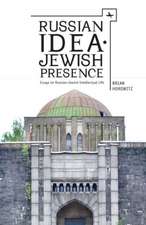Covenant of Blood: Circumcision and Gender in Rabbinic Judaism: Chicago Studies in the History of Judaism
Autor Lawrence A. Hoffmanen Limba Engleză Paperback – 7 feb 1996
Central to both biblical narrative and rabbinic commentary, circumcision has remained a defining rite of Jewish identity, a symbol so powerful that challenges to it have always been considered taboo. Lawrence Hoffman seeks to find out why circumcision holds such an important place in the Jewish psyche. He traces the symbolism of circumcision through Jewish history, examining its evolution as a symbol of the covenant in the post-exilic period of the Bible and its subsequent meaning in the formative era of Mishnah and Talmud.
In the rabbinic system, Hoffman argues, circumcision was neither a birth ritual nor the beginning of the human life cycle, but a rite of covenantal initiation into a male "life line." Although the evolution of the rite was shaped by rabbinic debates with early Christianity, the Rabbis shared with the church a view of blood as providing salvation. Hoffman examines the particular significance of circumcision blood, which, in addition to its salvific role, contrasted with menstrual blood to symbolize the gender dichotomy within the rabbinic system. His analysis of the Rabbis' views of circumcision and menstrual blood sheds light on the marginalization of women in rabbinic law. Differentiating official mores about gender from actual practice, Hoffman surveys women's spirituality within rabbinic society and examines the roles mothers played in their sons' circumcisions until the medieval period, when they were finally excluded.
In the rabbinic system, Hoffman argues, circumcision was neither a birth ritual nor the beginning of the human life cycle, but a rite of covenantal initiation into a male "life line." Although the evolution of the rite was shaped by rabbinic debates with early Christianity, the Rabbis shared with the church a view of blood as providing salvation. Hoffman examines the particular significance of circumcision blood, which, in addition to its salvific role, contrasted with menstrual blood to symbolize the gender dichotomy within the rabbinic system. His analysis of the Rabbis' views of circumcision and menstrual blood sheds light on the marginalization of women in rabbinic law. Differentiating official mores about gender from actual practice, Hoffman surveys women's spirituality within rabbinic society and examines the roles mothers played in their sons' circumcisions until the medieval period, when they were finally excluded.
Din seria Chicago Studies in the History of Judaism
-
 Preț: 215.52 lei
Preț: 215.52 lei -
 Preț: 321.18 lei
Preț: 321.18 lei -
 Preț: 293.81 lei
Preț: 293.81 lei -
 Preț: 263.53 lei
Preț: 263.53 lei -
 Preț: 261.66 lei
Preț: 261.66 lei -
 Preț: 291.90 lei
Preț: 291.90 lei -
 Preț: 312.70 lei
Preț: 312.70 lei -
 Preț: 294.96 lei
Preț: 294.96 lei -
 Preț: 284.56 lei
Preț: 284.56 lei -
 Preț: 293.04 lei
Preț: 293.04 lei -
 Preț: 231.56 lei
Preț: 231.56 lei -
 Preț: 315.58 lei
Preț: 315.58 lei -
 Preț: 263.57 lei
Preț: 263.57 lei -
 Preț: 320.80 lei
Preț: 320.80 lei -
 Preț: 248.05 lei
Preț: 248.05 lei - 20%
 Preț: 160.30 lei
Preț: 160.30 lei - 22%
 Preț: 522.75 lei
Preț: 522.75 lei - 12%
 Preț: 310.42 lei
Preț: 310.42 lei - 16%
 Preț: 261.16 lei
Preț: 261.16 lei
Preț: 288.42 lei
Nou
Puncte Express: 433
Preț estimativ în valută:
55.19€ • 59.02$ • 46.02£
55.19€ • 59.02$ • 46.02£
Carte tipărită la comandă
Livrare economică 18 aprilie-02 mai
Preluare comenzi: 021 569.72.76
Specificații
ISBN-13: 9780226347844
ISBN-10: 0226347842
Pagini: 262
Dimensiuni: 152 x 229 x 23 mm
Greutate: 0.36 kg
Ediția:1
Editura: University of Chicago Press
Colecția University of Chicago Press
Seria Chicago Studies in the History of Judaism
ISBN-10: 0226347842
Pagini: 262
Dimensiuni: 152 x 229 x 23 mm
Greutate: 0.36 kg
Ediția:1
Editura: University of Chicago Press
Colecția University of Chicago Press
Seria Chicago Studies in the History of Judaism
Notă biografică
Lawrence A. Hoffman is professor of liturgy at Hebrew Union College-Jewish Institute of Religion in New York. His many books include The Art of Public Prayer, Beyond the Text, and Canonization of the Synagogue Service. Hoffman co-edits Two Liturgical Traditions, a series exploring worship in Judaism and Christianity from antiquity to today.
Cuprins
1: Circumcision as Symbol in the Jewish Psyche
2: Bible and Birth: Some Priestly Public Meanings
3: Interlude from Priests to Rabbis: Origins of a Liturgy
4: Reconstructing the Rite
5: Reconstructing the Rabbinic Meaning System
6: Wine, Blood, and Salvation in Rabbinic Judaism
7: Blood, Salvation, Works, and Faith: Circumcision in Early Judaism and
Christianity
8: Gender Opposition in Rabbinic Judaism: Free-flowing Blood in a Culture
of Control
9: Control and Transformation: "The Raw and the Cooked" in Rabbinic Culture
10: Women's Spirituality and the Presence of Mothers in Rabbinic Ritual
11: Medieval Rabbinism and the Ritual Marginalization of Women
Afterword: Brit or Milah? Circumcision in American Culture
Notes
Index
2: Bible and Birth: Some Priestly Public Meanings
3: Interlude from Priests to Rabbis: Origins of a Liturgy
4: Reconstructing the Rite
5: Reconstructing the Rabbinic Meaning System
6: Wine, Blood, and Salvation in Rabbinic Judaism
7: Blood, Salvation, Works, and Faith: Circumcision in Early Judaism and
Christianity
8: Gender Opposition in Rabbinic Judaism: Free-flowing Blood in a Culture
of Control
9: Control and Transformation: "The Raw and the Cooked" in Rabbinic Culture
10: Women's Spirituality and the Presence of Mothers in Rabbinic Ritual
11: Medieval Rabbinism and the Ritual Marginalization of Women
Afterword: Brit or Milah? Circumcision in American Culture
Notes
Index













